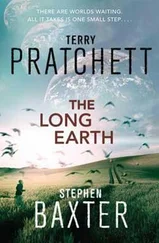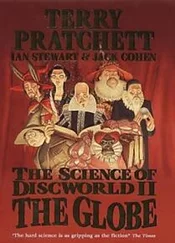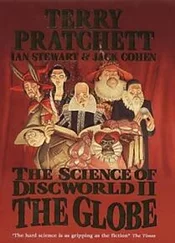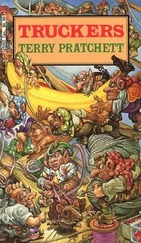Terry Pratchett - The Science of Discworld I
Здесь есть возможность читать онлайн «Terry Pratchett - The Science of Discworld I» весь текст электронной книги совершенно бесплатно (целиком полную версию без сокращений). В некоторых случаях можно слушать аудио, скачать через торрент в формате fb2 и присутствует краткое содержание. Жанр: Фантастика и фэнтези, на английском языке. Описание произведения, (предисловие) а так же отзывы посетителей доступны на портале библиотеки ЛибКат.
- Название:The Science of Discworld I
- Автор:
- Жанр:
- Год:неизвестен
- ISBN:нет данных
- Рейтинг книги:5 / 5. Голосов: 1
-
Избранное:Добавить в избранное
- Отзывы:
-
Ваша оценка:
- 100
- 1
- 2
- 3
- 4
- 5
The Science of Discworld I: краткое содержание, описание и аннотация
Предлагаем к чтению аннотацию, описание, краткое содержание или предисловие (зависит от того, что написал сам автор книги «The Science of Discworld I»). Если вы не нашли необходимую информацию о книге — напишите в комментариях, мы постараемся отыскать её.
The Science of Discworld I — читать онлайн бесплатно полную книгу (весь текст) целиком
Ниже представлен текст книги, разбитый по страницам. Система сохранения места последней прочитанной страницы, позволяет с удобством читать онлайн бесплатно книгу «The Science of Discworld I», без необходимости каждый раз заново искать на чём Вы остановились. Поставьте закладку, и сможете в любой момент перейти на страницу, на которой закончили чтение.
Интервал:
Закладка:
The idea that life could somehow be self-starting is still controversial to many people. Nevertheless, it turns out that finding plausible routes to life is easy. There must be at least thirty of them.
It's hard to decide which, if any, was the actual route taken, because later lifeforms have destroyed nearly all the evidence. This may not matter much: if life hadn't taken the route that it did, it could easily have taken one of the others, or one of the hundred we haven't thought of yet.
One possible route from the inorganic world to life, suggested by Graham Cairns-Smith, is clay. Clay can form complicated microscopic structures, and it often 'copies' an existing structure by adding an extra layer to it, which then falls off and becomes the starting point of a new structure. Carbon compounds can stick on to clay surfaces, where they can act as catalysts for the formation of complex molecules of the kind we see in living creatures, proteins, even DNA itself. So today's organisms may have hitched an evolutionary ride on clay.
An alternative is Gunther Wachterhauser's suggestion that pyrite, a compound of iron and sulphur, could have provided an energy source suitable for bacteria. Even today we find bacteria miles underground, and near volcanic vents at the bottom of the oceans, which power themselves by iron/sulphur reactions. These are the source of the 'upflow of poisonous minerals' noticed by Rincewind. It's entirely conceivable that life started in similar environments.
A potential problem with volcanic vents, though, is that every so often they get blocked, and another one breaks out somewhere else. How could the organisms get themselves safely across the intervening cold water? In 1988 Kevin Speer realized that the Earth's rotation causes the rising plumes of hot water from vents to spin, forming a kind of underwater hot tornado that moves through the deep ocean. Organisms could hitch a ride on these. Some might make it to another vent. Many would not, but that doesn't matter -all that would be required would be enough survivors.
It is interesting to note that back in the Cretaceous, when the seas were a lot warmer than now, these hot plumes could even have risen to the ocean's surface, where they may have caused 'hyper-canes', like hurricanes but with a windspeed close to that of sound. These would have caused major climatic upheavals on a planet which, as we shall see, it not the moderately peaceful place we tend to believe it is.
Bacteria belong to the grade of organisms known as prokaryotes. They are often said to be 'single-celled', but many single-celled creatures are far more complex and very different from bacteria. Bacteria are not true cells, but something simpler; they have no cell wall and no nucleus. True cells, and creatures both single-celled and many-celled, came later, and are called eukaryotes. They probably arose when several different prokaryotes joined forces to their mutual benefit, a trick known as symbiosis. The first fossil eukaryotes are singe-celled, like amoebas, and appear about 2 billion years ago. The first fossils of many-celled creatures are algae from 1 billion years ago ... maybe even as old as 1.8 billion years.
This was the story as scientists understood it up until 1998: animals like arthropods and other complex beasts came into being a mere 600 million years ago, and that until about 540 million years ago the only creatures were very strange indeed, quite unlike most of what's around today.
These creatures are known as Ediacarans, after a place in Australia where the first fossils were found [35] They were fortunate, given the names of some places in Australia, that they ended up merely sounding like a minor Star Trek species.
. They could grow to half a metre or more, but as far as can be told from the fossil record, seem not to have had any internal organs or external orifices like a mouth or an anus (they may have survived by digesting symbiotic bacteria in their selves, or by some other process we can only guess at). Some were flattened, and clustered together in quilts. We have no idea whether the Ediacarans were our distant ancestors, or whether they were a dead end, a lifestyle doomed to failure. No matter: they were around then, and as far as anyone knew, not much else was. There are hints of fossil wormcasts, though, and some very recent fossils look like ... but we're getting ahead of the story. The point is that nearly all Ediacaran life was apparently unrelated to what came later.
About 540 million years ago the Pre-Cambrian Ediacarans were succeeded by the creatures of the Cambrian era. For the first ten million years, these beasties were also pretty weird, leaving behind fragments of spines and spikes which presumably are the remains of prototype skeletons that hadn't yet joined up. At that point, nature suddenly learned how to do joined-up skeletons, and much else: this was the time known as the Cambrian Explosion. Twenty million years later virtually every body-plan found in modern animals was already in existence: everything afterwards was mere tinkering. The real innovation of the Cambrian Explosion, though, was less obvious than joined-up skeletons or tusks or shells or limbs. It was a new kind of body plan. Diploblasts were overtaken by triploblasts ...
Sorry, Archchancellor. We mean that creatures began to put another layer between themselves and the universe. Ediacarans and modern jellyfish are diploblasts, two-layered creatures. They have an inside and an outside, like a thick paper bag. Three-layered creatures like us and practically everything else around are called triploblasts. We have an inner, an outer, and a within.
The within was the big leap forward, or at least the big slither. Within you can put the things you need to protect, like internal organs. In one sense, you are not part of the environment any more, there is a you as well. And, like someone who now has a piece of property of their very own, you can begin to make improvements. This is a lie-to-children, but as lies go it is a good one. Triploblasts played a crucial role in evolution, precisely because they did have internal organs, and in particular they could ingest food and excrete it. Their excreta became a major resource for other creatures; to get an interestingly complicated world, it is vitally important that shit happens.
But where did all those triploblasts come from? Were they an offshoot of the Ediacarans? Or did they come from something else that didn't leave fossils?
It's hard to see how they could have come from Ediacarans. Yes, an extra layer of tissue might have appeared, but as well as that extra layer you need a lot of organization to exploit it. That organization has to come from somewhere. Moreover, there were these occasional tantalizing traces of what might have been pre-Cambrian triploblasts, fossils not of worms, which would have clinched it, but of things that might have been trails made by worms in wet mud.
And then again, might not.
In February 1998, we found out.
The discovery depended upon where, and in this case how -you look for fossils. One way for fossils to form is by petrification. There is a poorly known type of petrification that can happen very fast, within a few days. The soft parts of a dead organism are replaced by calcium phosphate. Unfortunately for palaeontologists, this process works only for organisms that are about a tenth of an inch (2 mm) long. Still, some interesting things are that tiny. From about 1975 onwards scientists found wonderfully preserved specimens of tiny ancient arthropods, creatures like centipedes with many segments. In 1994 they found fossilized balls of cells from embryos, early stages in the development of an organism, and it is thought that these come from embryonic triploblasts. However, all of these creatures must have come after the Ediacarans. But in 1998 Shuhai Xiao, Yun Zhang, and Andrew Knoll discovered fossilized embryos in Chinese rock that is 570 million years old -smack in the middle of the Ediacaran era. And those embryos were triploblasts.
Читать дальшеИнтервал:
Закладка:
Похожие книги на «The Science of Discworld I»
Представляем Вашему вниманию похожие книги на «The Science of Discworld I» списком для выбора. Мы отобрали схожую по названию и смыслу литературу в надежде предоставить читателям больше вариантов отыскать новые, интересные, ещё непрочитанные произведения.
Обсуждение, отзывы о книге «The Science of Discworld I» и просто собственные мнения читателей. Оставьте ваши комментарии, напишите, что Вы думаете о произведении, его смысле или главных героях. Укажите что конкретно понравилось, а что нет, и почему Вы так считаете.












